Project Report on Additive Manufacturing of Ti-6Al-4V Alloys
VerifiedAdded on 2023/01/17
|16
|3271
|29
Report
AI Summary
This report delves into the application of additive manufacturing (AM) techniques, specifically focusing on Ti-6Al-4V titanium alloys, a material extensively utilized in biomedical and aerospace industries. The study compares AM with conventional casting methods, examining the advantages of AM, particularly in low production volume and prototyping scenarios. The methodology involves 3D printing and casting of specimens, followed by heat treatment and metallographic analysis, including tensile testing to evaluate mechanical properties. The results highlight the impact of building orientation on the tensile properties, with anisotropic grain structures influencing strength. The discussion emphasizes the significance of AM's high cooling rates, potential defects like porosity, and the need for post-processing techniques like heat treatment to enhance the mechanical properties. The conclusion underscores the importance of Ti-6Al-4V in high-tech industries and the potential of AM to overcome challenges in manufacturing complex geometries and achieving desired mechanical characteristics, while addressing the need for further research to refine the understanding of thermal histories, solidification processes, and their impact on the final microstructure and mechanical properties. The report also references the problem of product imprecision and wax distortion encountered during wax casting and how modern AM addresses these problems.
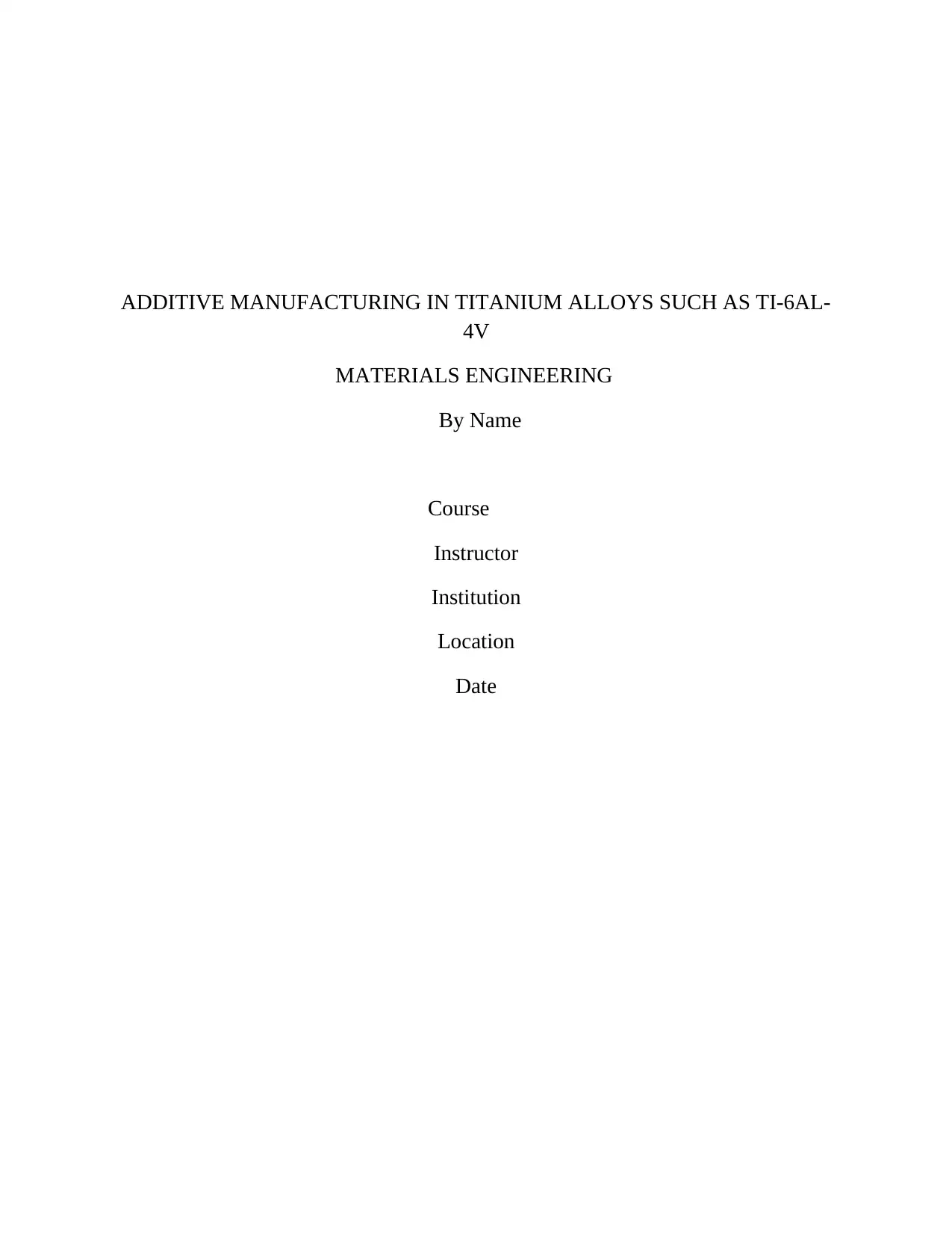
ADDITIVE MANUFACTURING IN TITANIUM ALLOYS SUCH AS TI-6AL-
4V
MATERIALS ENGINEERING
By Name
Course
Instructor
Institution
Location
Date
4V
MATERIALS ENGINEERING
By Name
Course
Instructor
Institution
Location
Date
Paraphrase This Document
Need a fresh take? Get an instant paraphrase of this document with our AI Paraphraser
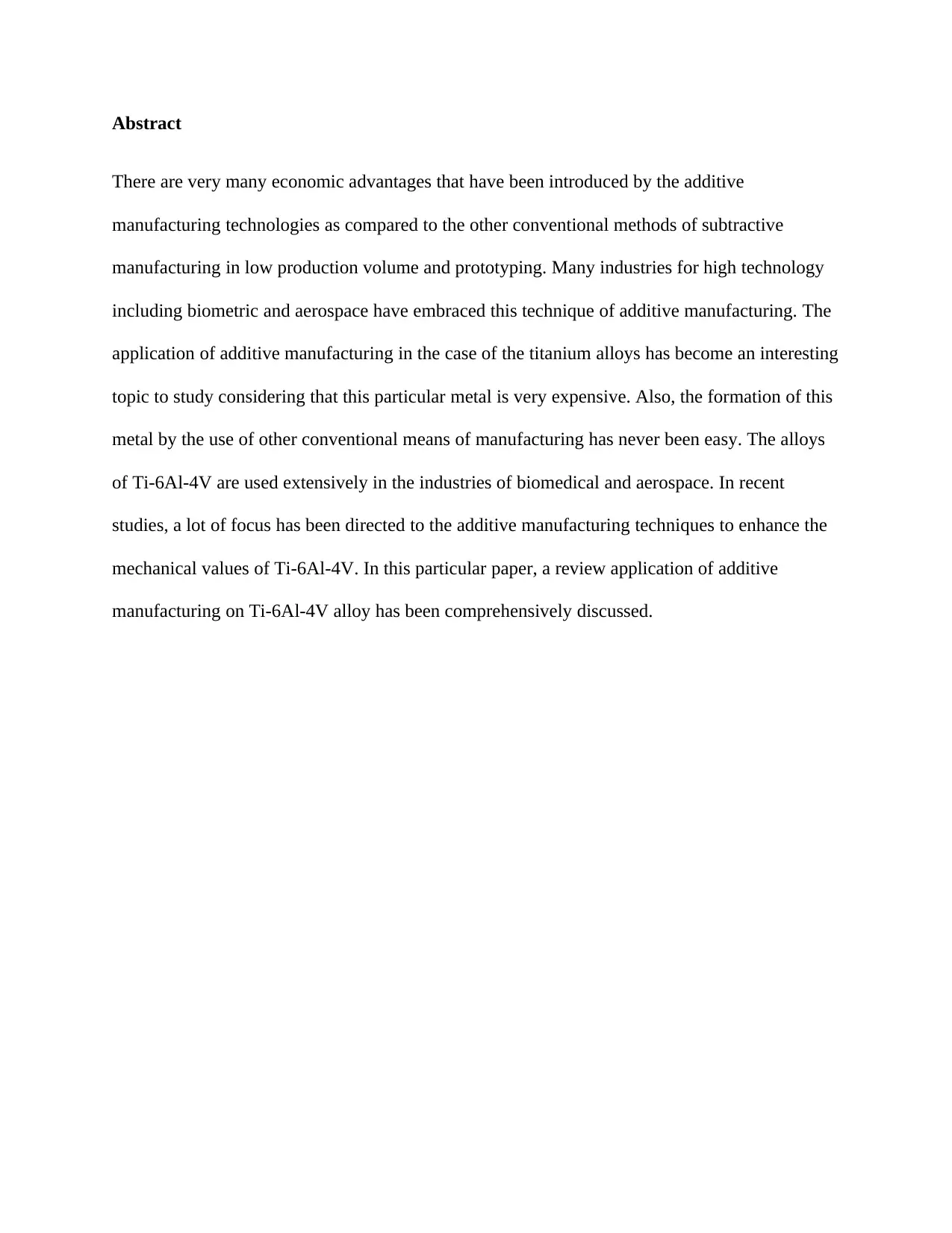
Abstract
There are very many economic advantages that have been introduced by the additive
manufacturing technologies as compared to the other conventional methods of subtractive
manufacturing in low production volume and prototyping. Many industries for high technology
including biometric and aerospace have embraced this technique of additive manufacturing. The
application of additive manufacturing in the case of the titanium alloys has become an interesting
topic to study considering that this particular metal is very expensive. Also, the formation of this
metal by the use of other conventional means of manufacturing has never been easy. The alloys
of Ti-6Al-4V are used extensively in the industries of biomedical and aerospace. In recent
studies, a lot of focus has been directed to the additive manufacturing techniques to enhance the
mechanical values of Ti-6Al-4V. In this particular paper, a review application of additive
manufacturing on Ti-6Al-4V alloy has been comprehensively discussed.
There are very many economic advantages that have been introduced by the additive
manufacturing technologies as compared to the other conventional methods of subtractive
manufacturing in low production volume and prototyping. Many industries for high technology
including biometric and aerospace have embraced this technique of additive manufacturing. The
application of additive manufacturing in the case of the titanium alloys has become an interesting
topic to study considering that this particular metal is very expensive. Also, the formation of this
metal by the use of other conventional means of manufacturing has never been easy. The alloys
of Ti-6Al-4V are used extensively in the industries of biomedical and aerospace. In recent
studies, a lot of focus has been directed to the additive manufacturing techniques to enhance the
mechanical values of Ti-6Al-4V. In this particular paper, a review application of additive
manufacturing on Ti-6Al-4V alloy has been comprehensively discussed.
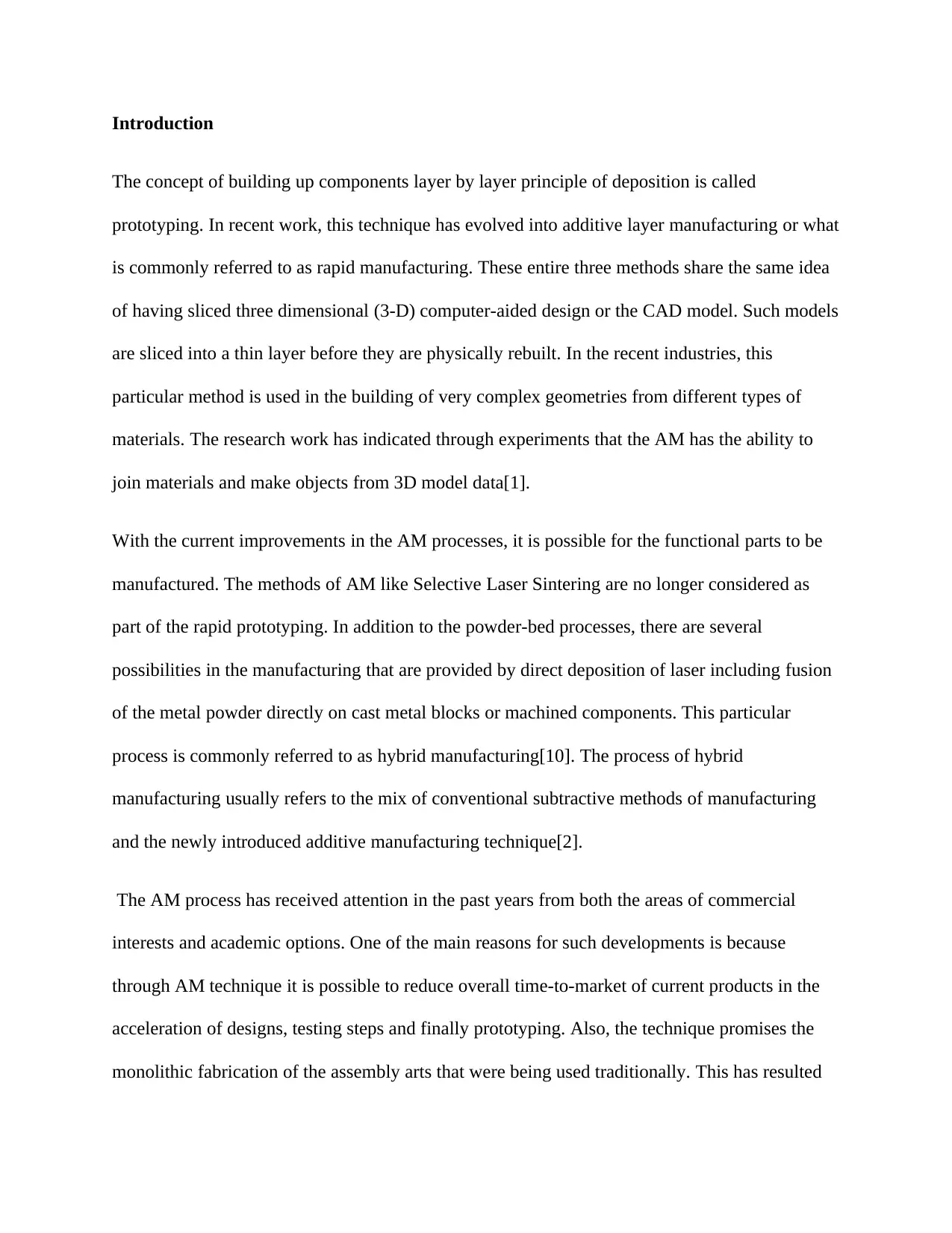
Introduction
The concept of building up components layer by layer principle of deposition is called
prototyping. In recent work, this technique has evolved into additive layer manufacturing or what
is commonly referred to as rapid manufacturing. These entire three methods share the same idea
of having sliced three dimensional (3-D) computer-aided design or the CAD model. Such models
are sliced into a thin layer before they are physically rebuilt. In the recent industries, this
particular method is used in the building of very complex geometries from different types of
materials. The research work has indicated through experiments that the AM has the ability to
join materials and make objects from 3D model data[1].
With the current improvements in the AM processes, it is possible for the functional parts to be
manufactured. The methods of AM like Selective Laser Sintering are no longer considered as
part of the rapid prototyping. In addition to the powder-bed processes, there are several
possibilities in the manufacturing that are provided by direct deposition of laser including fusion
of the metal powder directly on cast metal blocks or machined components. This particular
process is commonly referred to as hybrid manufacturing[10]. The process of hybrid
manufacturing usually refers to the mix of conventional subtractive methods of manufacturing
and the newly introduced additive manufacturing technique[2].
The AM process has received attention in the past years from both the areas of commercial
interests and academic options. One of the main reasons for such developments is because
through AM technique it is possible to reduce overall time-to-market of current products in the
acceleration of designs, testing steps and finally prototyping. Also, the technique promises the
monolithic fabrication of the assembly arts that were being used traditionally. This has resulted
The concept of building up components layer by layer principle of deposition is called
prototyping. In recent work, this technique has evolved into additive layer manufacturing or what
is commonly referred to as rapid manufacturing. These entire three methods share the same idea
of having sliced three dimensional (3-D) computer-aided design or the CAD model. Such models
are sliced into a thin layer before they are physically rebuilt. In the recent industries, this
particular method is used in the building of very complex geometries from different types of
materials. The research work has indicated through experiments that the AM has the ability to
join materials and make objects from 3D model data[1].
With the current improvements in the AM processes, it is possible for the functional parts to be
manufactured. The methods of AM like Selective Laser Sintering are no longer considered as
part of the rapid prototyping. In addition to the powder-bed processes, there are several
possibilities in the manufacturing that are provided by direct deposition of laser including fusion
of the metal powder directly on cast metal blocks or machined components. This particular
process is commonly referred to as hybrid manufacturing[10]. The process of hybrid
manufacturing usually refers to the mix of conventional subtractive methods of manufacturing
and the newly introduced additive manufacturing technique[2].
The AM process has received attention in the past years from both the areas of commercial
interests and academic options. One of the main reasons for such developments is because
through AM technique it is possible to reduce overall time-to-market of current products in the
acceleration of designs, testing steps and finally prototyping. Also, the technique promises the
monolithic fabrication of the assembly arts that were being used traditionally. This has resulted
⊘ This is a preview!⊘
Do you want full access?
Subscribe today to unlock all pages.

Trusted by 1+ million students worldwide

in the reduction of the weight through the removal of the fasteners from the complex equation.
They’re very many applications of the AM that have gained acceptance including fuel nozzles,
unmanned aerial vehicles, biomedical implants, and houses[11].
The problem statement of the research
Casting machine for titanium has been in use for a long time in the development of various
components. The heating of the titanium is normally done in a vacuum atmosphere and this will
always ensure that the melting points are kept as low as possible during the melting of the metal.
There are several problems that have been encountered by the professionals during the wax
casting technology in their daily routine[3]. These problems among other include distortion of
wax and the defects of casting that may possibly result in the product imprecision. The study,
therefore, seeks to evaluate the significance of modern additive manufacturing and other casting
technology through experimental setups as a way to address these problems.
Methodology and experimental design of research
Materials and methods
Casting
The specimen of the casts was generated with a Dentaurum Universal 230. This particular
component is usually an autocast casting unit. The first step involved 3D-printing of the
specimen from a material of polymeric[12]. There was making of a pre-designed model during
the process of manufacturing before the wax pattern could be embedded. The wax copy was
made with the help of material of silicone casting. This was then followed by spring and ceramic
embedding. The open-pore embedding material, as well as the interior pattern, was burnt out in
They’re very many applications of the AM that have gained acceptance including fuel nozzles,
unmanned aerial vehicles, biomedical implants, and houses[11].
The problem statement of the research
Casting machine for titanium has been in use for a long time in the development of various
components. The heating of the titanium is normally done in a vacuum atmosphere and this will
always ensure that the melting points are kept as low as possible during the melting of the metal.
There are several problems that have been encountered by the professionals during the wax
casting technology in their daily routine[3]. These problems among other include distortion of
wax and the defects of casting that may possibly result in the product imprecision. The study,
therefore, seeks to evaluate the significance of modern additive manufacturing and other casting
technology through experimental setups as a way to address these problems.
Methodology and experimental design of research
Materials and methods
Casting
The specimen of the casts was generated with a Dentaurum Universal 230. This particular
component is usually an autocast casting unit. The first step involved 3D-printing of the
specimen from a material of polymeric[12]. There was making of a pre-designed model during
the process of manufacturing before the wax pattern could be embedded. The wax copy was
made with the help of material of silicone casting. This was then followed by spring and ceramic
embedding. The open-pore embedding material, as well as the interior pattern, was burnt out in
Paraphrase This Document
Need a fresh take? Get an instant paraphrase of this document with our AI Paraphraser
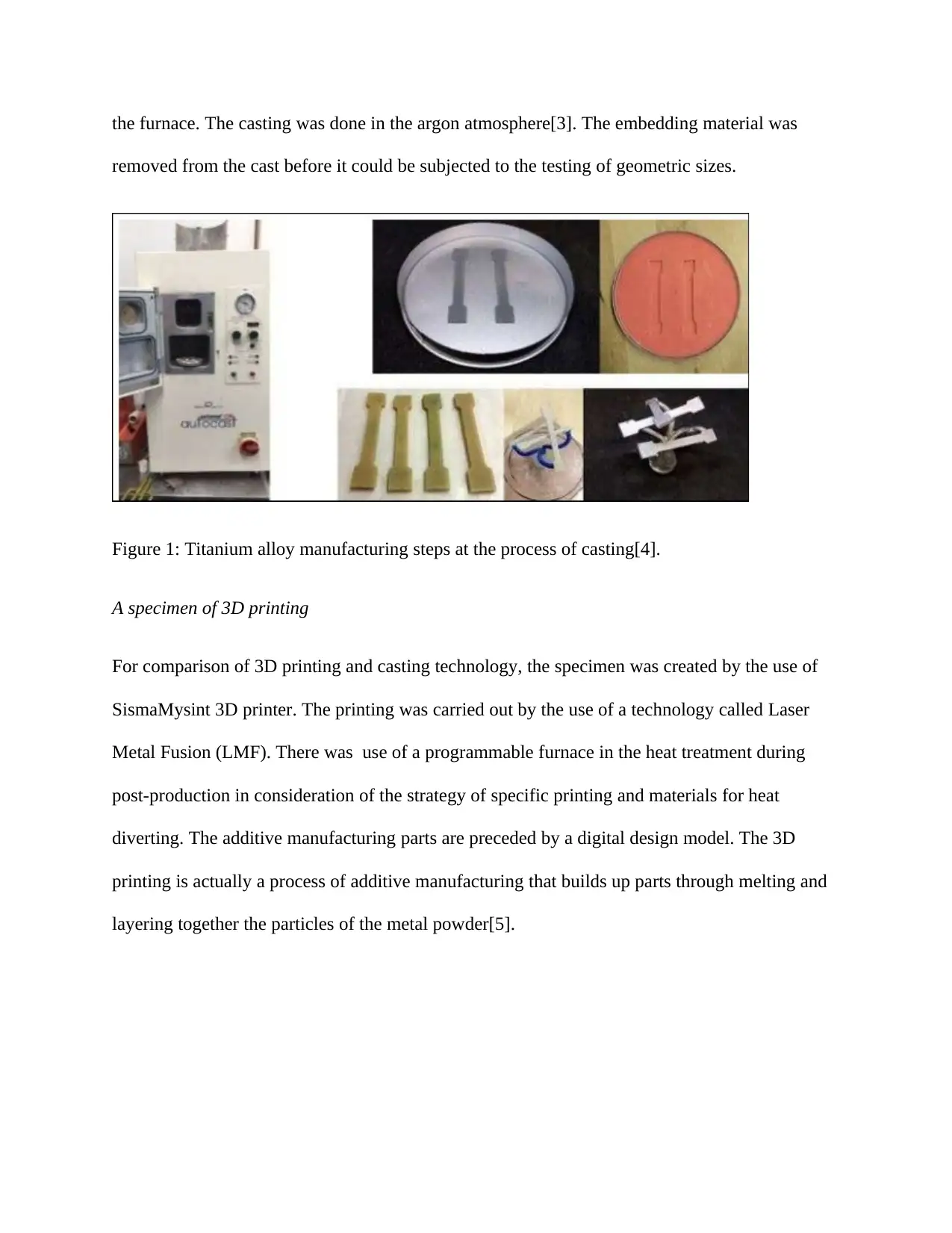
the furnace. The casting was done in the argon atmosphere[3]. The embedding material was
removed from the cast before it could be subjected to the testing of geometric sizes.
Figure 1: Titanium alloy manufacturing steps at the process of casting[4].
A specimen of 3D printing
For comparison of 3D printing and casting technology, the specimen was created by the use of
SismaMysint 3D printer. The printing was carried out by the use of a technology called Laser
Metal Fusion (LMF). There was use of a programmable furnace in the heat treatment during
post-production in consideration of the strategy of specific printing and materials for heat
diverting. The additive manufacturing parts are preceded by a digital design model. The 3D
printing is actually a process of additive manufacturing that builds up parts through melting and
layering together the particles of the metal powder[5].
removed from the cast before it could be subjected to the testing of geometric sizes.
Figure 1: Titanium alloy manufacturing steps at the process of casting[4].
A specimen of 3D printing
For comparison of 3D printing and casting technology, the specimen was created by the use of
SismaMysint 3D printer. The printing was carried out by the use of a technology called Laser
Metal Fusion (LMF). There was use of a programmable furnace in the heat treatment during
post-production in consideration of the strategy of specific printing and materials for heat
diverting. The additive manufacturing parts are preceded by a digital design model. The 3D
printing is actually a process of additive manufacturing that builds up parts through melting and
layering together the particles of the metal powder[5].
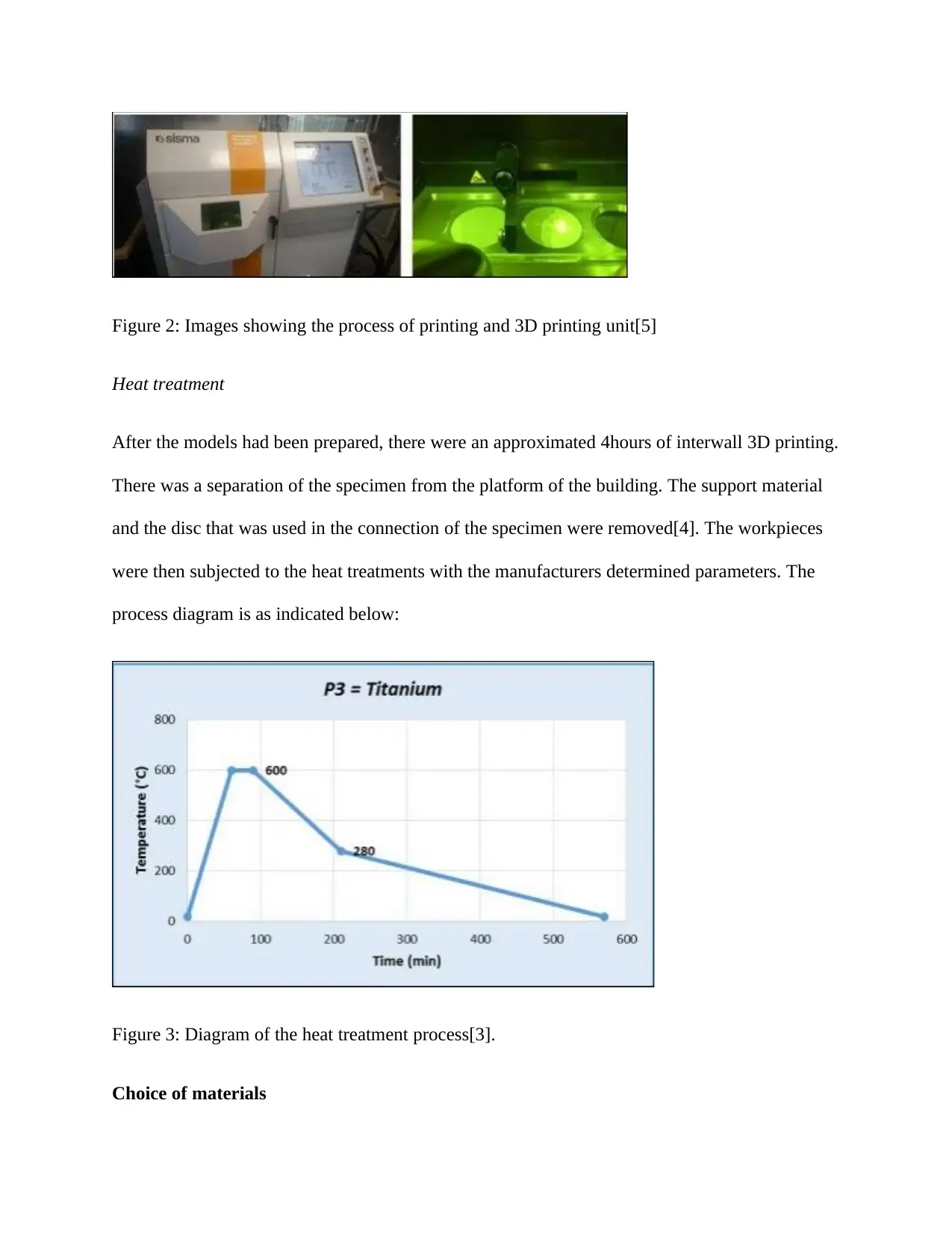
Figure 2: Images showing the process of printing and 3D printing unit[5]
Heat treatment
After the models had been prepared, there were an approximated 4hours of interwall 3D printing.
There was a separation of the specimen from the platform of the building. The support material
and the disc that was used in the connection of the specimen were removed[4]. The workpieces
were then subjected to the heat treatments with the manufacturers determined parameters. The
process diagram is as indicated below:
Figure 3: Diagram of the heat treatment process[3].
Choice of materials
Heat treatment
After the models had been prepared, there were an approximated 4hours of interwall 3D printing.
There was a separation of the specimen from the platform of the building. The support material
and the disc that was used in the connection of the specimen were removed[4]. The workpieces
were then subjected to the heat treatments with the manufacturers determined parameters. The
process diagram is as indicated below:
Figure 3: Diagram of the heat treatment process[3].
Choice of materials
⊘ This is a preview!⊘
Do you want full access?
Subscribe today to unlock all pages.

Trusted by 1+ million students worldwide
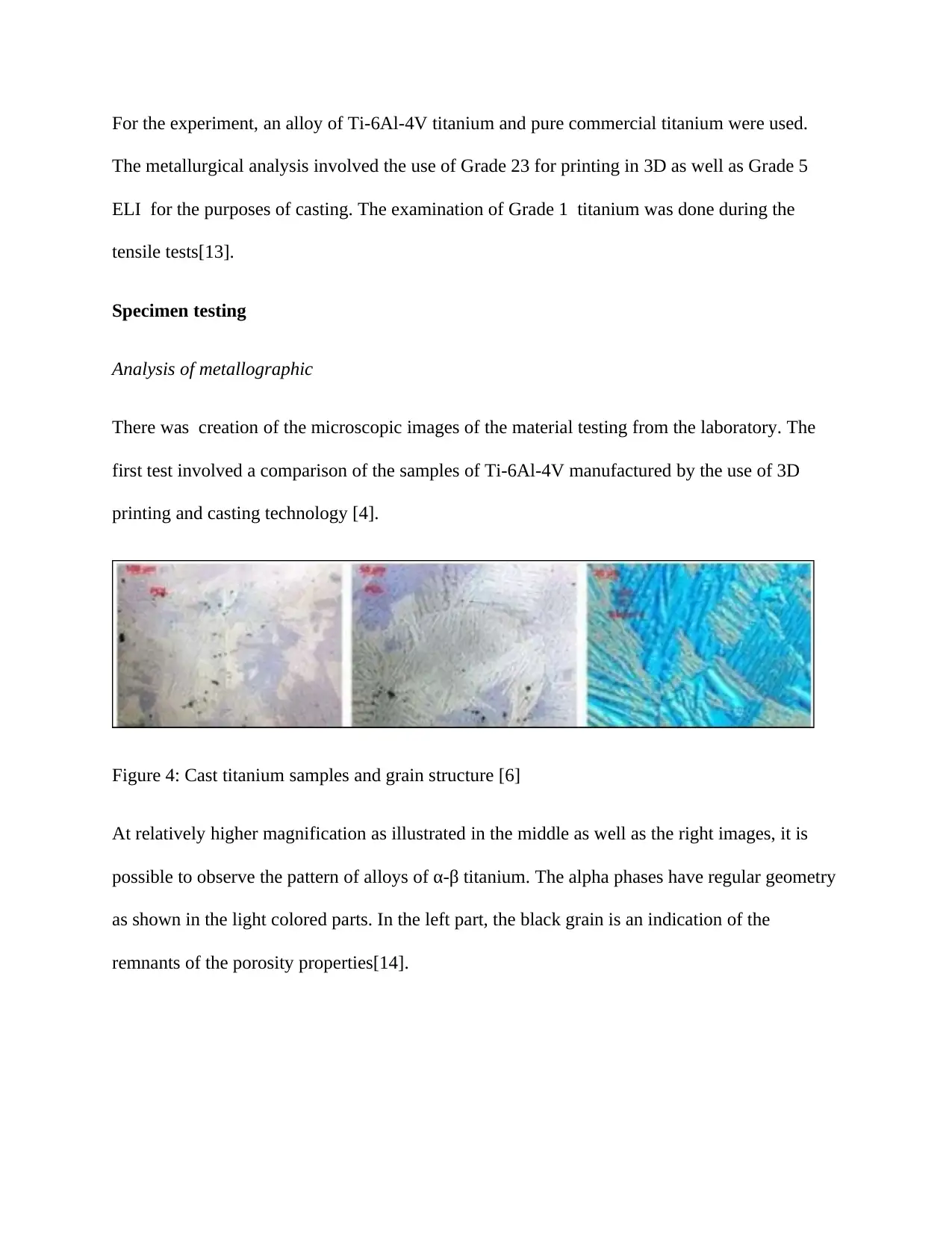
For the experiment, an alloy of Ti-6Al-4V titanium and pure commercial titanium were used.
The metallurgical analysis involved the use of Grade 23 for printing in 3D as well as Grade 5
ELI for the purposes of casting. The examination of Grade 1 titanium was done during the
tensile tests[13].
Specimen testing
Analysis of metallographic
There was creation of the microscopic images of the material testing from the laboratory. The
first test involved a comparison of the samples of Ti-6Al-4V manufactured by the use of 3D
printing and casting technology [4].
Figure 4: Cast titanium samples and grain structure [6]
At relatively higher magnification as illustrated in the middle as well as the right images, it is
possible to observe the pattern of alloys of α-β titanium. The alpha phases have regular geometry
as shown in the light colored parts. In the left part, the black grain is an indication of the
remnants of the porosity properties[14].
The metallurgical analysis involved the use of Grade 23 for printing in 3D as well as Grade 5
ELI for the purposes of casting. The examination of Grade 1 titanium was done during the
tensile tests[13].
Specimen testing
Analysis of metallographic
There was creation of the microscopic images of the material testing from the laboratory. The
first test involved a comparison of the samples of Ti-6Al-4V manufactured by the use of 3D
printing and casting technology [4].
Figure 4: Cast titanium samples and grain structure [6]
At relatively higher magnification as illustrated in the middle as well as the right images, it is
possible to observe the pattern of alloys of α-β titanium. The alpha phases have regular geometry
as shown in the light colored parts. In the left part, the black grain is an indication of the
remnants of the porosity properties[14].
Paraphrase This Document
Need a fresh take? Get an instant paraphrase of this document with our AI Paraphraser

Figure 5: 3D printed titanium samples and grain structure [4].
The above figures illustrate the structure of the grain after 3D printing. The middle and the left
images were shot at various expositions after the exercise of etching. The image on the right
section is a picture of samples before etching.
Tensile site testing
During the procedure of tensile testing, the 3D material that had been previously introduced was
compared with the commercially pure titanium. This kind of commercial titanium is widely used
in the practices of dentistry in the creation of cast parts. The test specimens were fixed into the
tensile testing machine. The specimens were then subjected to tension until failure.
Results
The state of the specimen after they had been undertaken through the process of testing is as
shown in the figure below. It is possible to observe the fracture in the right image. This is an
indication of the brittle signs [5].
The above figures illustrate the structure of the grain after 3D printing. The middle and the left
images were shot at various expositions after the exercise of etching. The image on the right
section is a picture of samples before etching.
Tensile site testing
During the procedure of tensile testing, the 3D material that had been previously introduced was
compared with the commercially pure titanium. This kind of commercial titanium is widely used
in the practices of dentistry in the creation of cast parts. The test specimens were fixed into the
tensile testing machine. The specimens were then subjected to tension until failure.
Results
The state of the specimen after they had been undertaken through the process of testing is as
shown in the figure below. It is possible to observe the fracture in the right image. This is an
indication of the brittle signs [5].
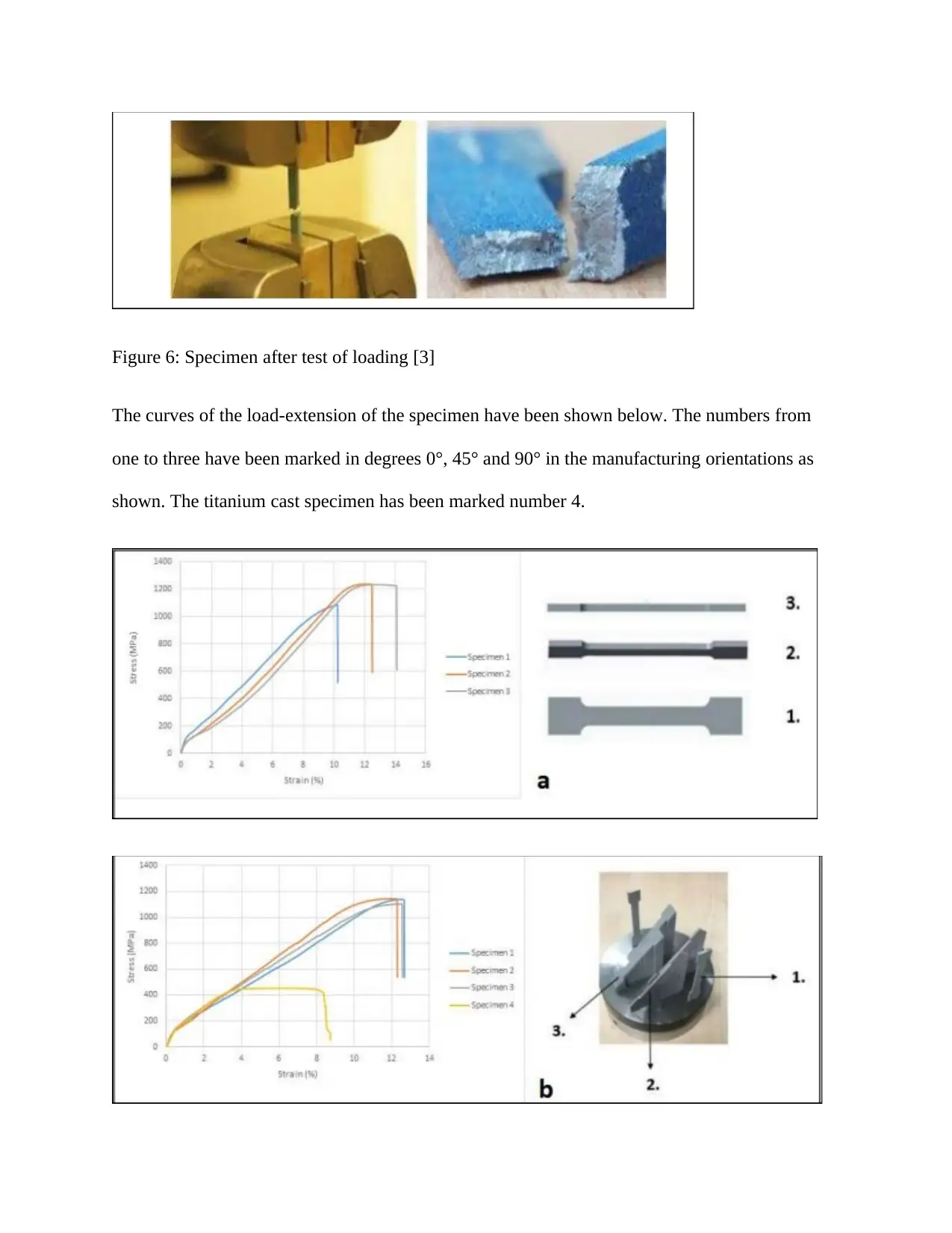
Figure 6: Specimen after test of loading [3]
The curves of the load-extension of the specimen have been shown below. The numbers from
one to three have been marked in degrees 0°, 45° and 90° in the manufacturing orientations as
shown. The titanium cast specimen has been marked number 4.
The curves of the load-extension of the specimen have been shown below. The numbers from
one to three have been marked in degrees 0°, 45° and 90° in the manufacturing orientations as
shown. The titanium cast specimen has been marked number 4.
⊘ This is a preview!⊘
Do you want full access?
Subscribe today to unlock all pages.

Trusted by 1+ million students worldwide

Figure 6: Lode extension curves obtained from various orientations of printing [4]
The material properties as determined by the tensile testing were as illustrated in the table below
Table 1: Material properties as determined by the tensile testing [2]
Table 2: Material specimen as determined by tensile testing [3].
The difference in the values of the strength values originates from the anisotropic structure of the
grain. The elongated grains in the specimen have been parallel to the load which is actually
favorable in the view of the mechanical point of view[15]. The elongation grains are however
directed perpendicularly to the load. There are more boundaries that are present in the direction
of stress. This kind of orientation is actually mechanically unfavorable. The orientation which is
45 degrees in considered being the transition between two cases. It is actually noticed that higher
values are found in the second group. This kind of value distinctness raised other issues about the
structure melting of the packed layers and the specimen orientation[16].
The material properties as determined by the tensile testing were as illustrated in the table below
Table 1: Material properties as determined by the tensile testing [2]
Table 2: Material specimen as determined by tensile testing [3].
The difference in the values of the strength values originates from the anisotropic structure of the
grain. The elongated grains in the specimen have been parallel to the load which is actually
favorable in the view of the mechanical point of view[15]. The elongation grains are however
directed perpendicularly to the load. There are more boundaries that are present in the direction
of stress. This kind of orientation is actually mechanically unfavorable. The orientation which is
45 degrees in considered being the transition between two cases. It is actually noticed that higher
values are found in the second group. This kind of value distinctness raised other issues about the
structure melting of the packed layers and the specimen orientation[16].
Paraphrase This Document
Need a fresh take? Get an instant paraphrase of this document with our AI Paraphraser

Table 3: properties after the process of casting [7]
The comparison of the mechanical properties of an alloy of Ti-6Al-4V titanium literature and the
one obtained after the heat treatment and additive manufacturing. The values from the supplied
literature are indications of ground, rolled and fiber materials. The component was never
subjected to heat treatment prior to the machining process.
Table 4: 3d-printed and fiber data materials [7].
Discussion
In the study, the mechanical properties and the microstructure of additive manufactured d Ti-
6Al-4V were investigated[17]. The inspection of the microscopic parts revealed that all the
components with periodic dentation illustrating layers of separate steps of AM. The etching
agent was considered to be 3 vol. % hydrofluoric acid in water and 6vol. % nitric acid.
Mechanical characterization of the components is usually considered an important procedure all
the design and other processes of manufacturing [6]. There are various tests of the machine that
could be used so as to effectively determine the mechanical properties of the components. Some
of these mechanical testing included hardness, fracture toughness, failures, impact resistance and
finally fatigue test. The tensile properties of the AM values were determined by the used of the
The comparison of the mechanical properties of an alloy of Ti-6Al-4V titanium literature and the
one obtained after the heat treatment and additive manufacturing. The values from the supplied
literature are indications of ground, rolled and fiber materials. The component was never
subjected to heat treatment prior to the machining process.
Table 4: 3d-printed and fiber data materials [7].
Discussion
In the study, the mechanical properties and the microstructure of additive manufactured d Ti-
6Al-4V were investigated[17]. The inspection of the microscopic parts revealed that all the
components with periodic dentation illustrating layers of separate steps of AM. The etching
agent was considered to be 3 vol. % hydrofluoric acid in water and 6vol. % nitric acid.
Mechanical characterization of the components is usually considered an important procedure all
the design and other processes of manufacturing [6]. There are various tests of the machine that
could be used so as to effectively determine the mechanical properties of the components. Some
of these mechanical testing included hardness, fracture toughness, failures, impact resistance and
finally fatigue test. The tensile properties of the AM values were determined by the used of the
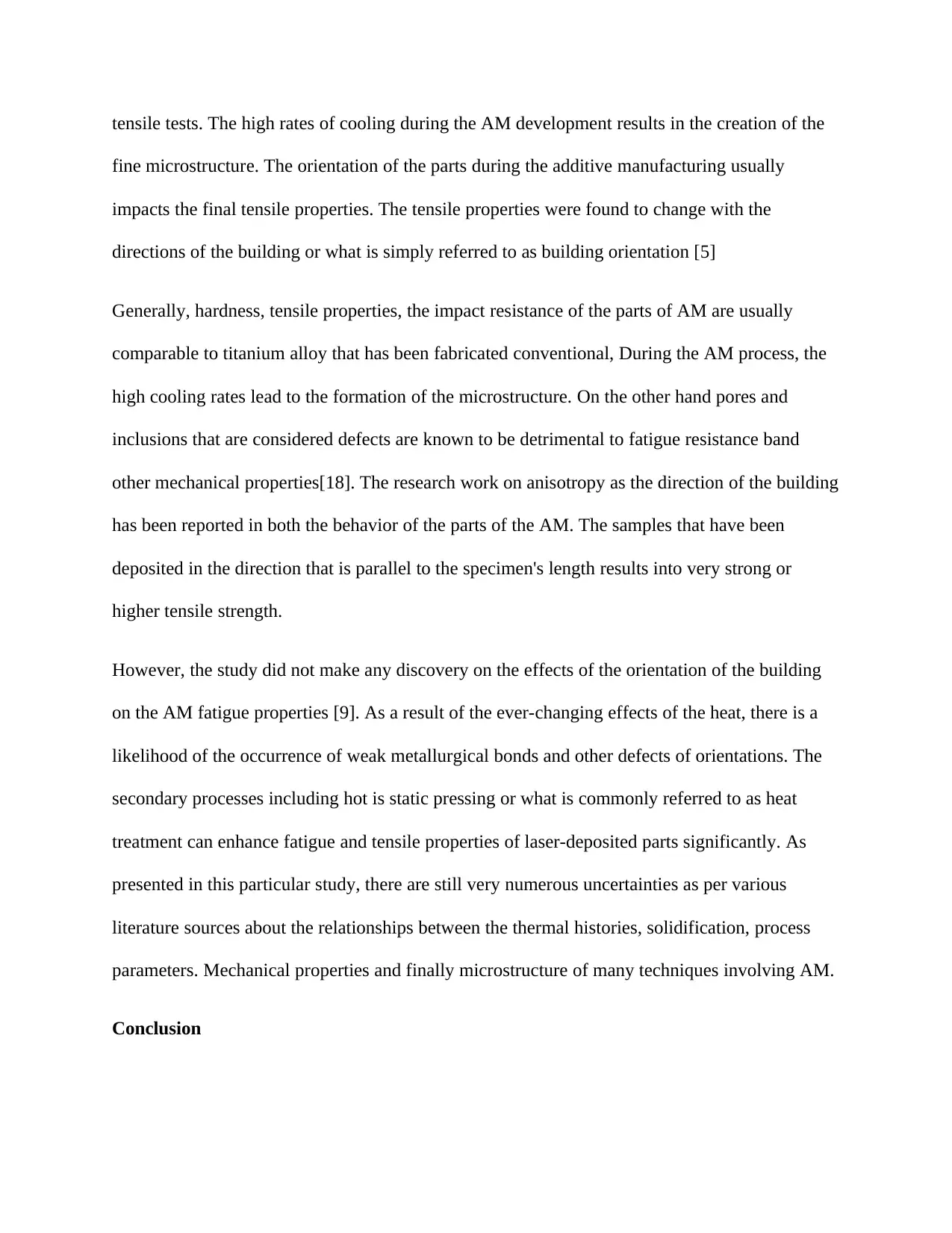
tensile tests. The high rates of cooling during the AM development results in the creation of the
fine microstructure. The orientation of the parts during the additive manufacturing usually
impacts the final tensile properties. The tensile properties were found to change with the
directions of the building or what is simply referred to as building orientation [5]
Generally, hardness, tensile properties, the impact resistance of the parts of AM are usually
comparable to titanium alloy that has been fabricated conventional, During the AM process, the
high cooling rates lead to the formation of the microstructure. On the other hand pores and
inclusions that are considered defects are known to be detrimental to fatigue resistance band
other mechanical properties[18]. The research work on anisotropy as the direction of the building
has been reported in both the behavior of the parts of the AM. The samples that have been
deposited in the direction that is parallel to the specimen's length results into very strong or
higher tensile strength.
However, the study did not make any discovery on the effects of the orientation of the building
on the AM fatigue properties [9]. As a result of the ever-changing effects of the heat, there is a
likelihood of the occurrence of weak metallurgical bonds and other defects of orientations. The
secondary processes including hot is static pressing or what is commonly referred to as heat
treatment can enhance fatigue and tensile properties of laser-deposited parts significantly. As
presented in this particular study, there are still very numerous uncertainties as per various
literature sources about the relationships between the thermal histories, solidification, process
parameters. Mechanical properties and finally microstructure of many techniques involving AM.
Conclusion
fine microstructure. The orientation of the parts during the additive manufacturing usually
impacts the final tensile properties. The tensile properties were found to change with the
directions of the building or what is simply referred to as building orientation [5]
Generally, hardness, tensile properties, the impact resistance of the parts of AM are usually
comparable to titanium alloy that has been fabricated conventional, During the AM process, the
high cooling rates lead to the formation of the microstructure. On the other hand pores and
inclusions that are considered defects are known to be detrimental to fatigue resistance band
other mechanical properties[18]. The research work on anisotropy as the direction of the building
has been reported in both the behavior of the parts of the AM. The samples that have been
deposited in the direction that is parallel to the specimen's length results into very strong or
higher tensile strength.
However, the study did not make any discovery on the effects of the orientation of the building
on the AM fatigue properties [9]. As a result of the ever-changing effects of the heat, there is a
likelihood of the occurrence of weak metallurgical bonds and other defects of orientations. The
secondary processes including hot is static pressing or what is commonly referred to as heat
treatment can enhance fatigue and tensile properties of laser-deposited parts significantly. As
presented in this particular study, there are still very numerous uncertainties as per various
literature sources about the relationships between the thermal histories, solidification, process
parameters. Mechanical properties and finally microstructure of many techniques involving AM.
Conclusion
⊘ This is a preview!⊘
Do you want full access?
Subscribe today to unlock all pages.

Trusted by 1+ million students worldwide
1 out of 16
Related Documents
Your All-in-One AI-Powered Toolkit for Academic Success.
+13062052269
info@desklib.com
Available 24*7 on WhatsApp / Email
![[object Object]](/_next/static/media/star-bottom.7253800d.svg)
Unlock your academic potential
Copyright © 2020–2025 A2Z Services. All Rights Reserved. Developed and managed by ZUCOL.





